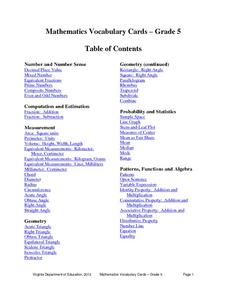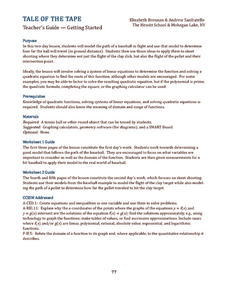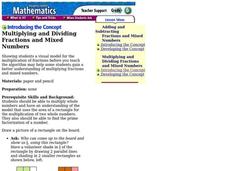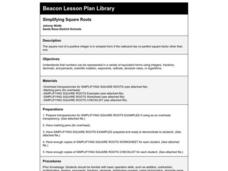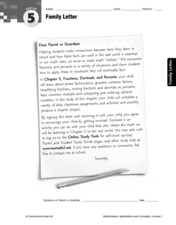Curated OER
Range, Cluster, Gap and Outliers
There are a number of activities here where learners collect and record data, as well as, activities where the likelihood of an event happening is calculated given the experimental probability. Young statisticians organize information...
Virginia Department of Education
Mathematics Vocabulary Cards - Grade 5
Elevate your fifth graders' understanding of math concepts with a series of vocabulary posters. Featuring terms concerning probability and statistics, measurement, algebra, and decimal place value (and many more), the posters are sure to...
Beacon Learning Center
Ten Pins
Multiplying with multiples of 10, 100, and 1,000 provides an opportunity to discuss patterns that arise with zeros. The class uses these patterns to solve problems. Then they rotate through three work stations, including a computer-based...
Curated OER
Tale of the Tape
How can baseball and skeet-shooting be modeled mathematically? Sports lovers and young mathematicians learn how to use quadratic equations and systems of equations to model the flight paths of various objects.
Curated OER
Exponential Expressions - Perfect Squares, Square Roots
Color tiles are used to model perfect squares. Alone or in pairs, middle schoolers will find patterns. Afterward, the relationship between perfect squares and roots will be discussed as a whole class.
Curated OER
Twenty Questions: The Hundred Chart
Use the 20 Questions game to practice math vocabulary and number properties! Project a hundreds chart and hand one out to learners. Ideally, give them counters (beans would work well) to mark off the chart so you can play multiple times....
Chapman University
Fundamental Theorems of Mathematics
There are four fundamental theorems of mathematics: arithmetic, algebra, calculus, and linear algebra listed here. Each one is described on this poster or handout. The challenge for a student of math is to figure out why they are true.
Curated OER
Introductory Algebra Chapter R Review
In this math worksheet, students solve the problems and simplify the fractions. Each of the sets is related to the instructional objectives.
Curated OER
Least Common Multiple Practice 2
In this least common multiples practice worksheet, students examine sample problems and solve 20 problems that require them to find least common multiples.
Curated OER
Least Common Multiple Practice
In this least common multiples practice worksheet, students examine sample problems and solve 20 problems that require them to find least common multiples.
Curated OER
Least Common Multiple Practice 3
In this least common multiples practice activity, students examine sample problems and solve 20 problems that require them to find least common multiples.
Curated OER
In Search of Self: Adolescent Themes in the Twentieth Century Short Story
Students read short stories that are related to adolescent issues and behaviors. In groups, they review the elements of a short story and vocabulary they might need while reading. To end the lesson, they read "Sir Tatton Sykes"...
Curated OER
Number Line Mathematics
Students translate problem situations into diagrams, models, and numerals using whole numbers, fractions, mixed numbers, decimals, and percents. They identify that numbers in different forms are equivalent or not equivalent using whole...
Curated OER
Pascal's Triangle
Students explore the concept of Pascal's Triangle. In this Pascal's Triangle lesson, students use an applet called 'Coloring Multiples' to explore Pascal's Triangle. Students develop patterns starting with various numbers in Pascal's...
Curated OER
Multiplying and Dividing Fractions and Mixed Numbers
Help math learners discover how to multiply fractions and mixed numbers. They will explore visual examples of the operations. They also practice solving problems that their instructor models.
Curated OER
Simplifying Square Roots
Discuss the definition for a simplified form for a square root. Middle schoolers analyze different forms of a square root, the Product Property of Square Roots, and complete a worksheet.
Curated OER
Writing Variable Expressions for Physical Models
Explore the concept of writing variable expressions by examining the similarities between expressions with numbers and expressions with variables. Emerging mathematicians determine rules for sequences and patterns before writing a rule...
Curated OER
Multiplying and Dividing Fractions and Mixed Numbers
Upper graders study fraction and mixed number division and also review fraction multiplication. In this fraction and mixed numbers lesson, learners work with the teacher in an oral problem solving method to multiply and divide fractions...
Curated OER
Family Activity - Color by Numbers: Fractions, Decimals, and Percents
Learners solve four short answer problems. They determine the number of each color of candy or paper clip in a bag, and calculate the fractional, decimal, and percentage representation of the color compared to the total number of items.
Historica-Dominion Institute
Underground Railroad - Secondary
This is a one-day activity to explore the Underground Railroad and its impact on Canadian immigration. Class members explore the government's immigration policies in the past and present. It requires viewing a short video clip and...
Curated OER
Vocabulary Challenge
In this math vocabulary worksheet, students choose which multiple choice answer best defines twenty-five mathematical terms. Students place their answers on the lines provided.
Curated OER
Probability of Numbers Worksheet
In this problem solving activity, students read a word problem and solve 5 probability scenarios from the word problem. Students work out each scenario in the work space provided.
Curated OER
The Cold War (1945–1963)
For this online interactive history worksheet, students respond to 8 short answer and essay questions about the Cold War. Students may check some of their answers on the interactive worksheet.
Curated OER
Conditional Statements
In this geometry worksheet, students read given sentences and identify the hypothesis and the conclusion of the conditional statements. There are 21 questions.



